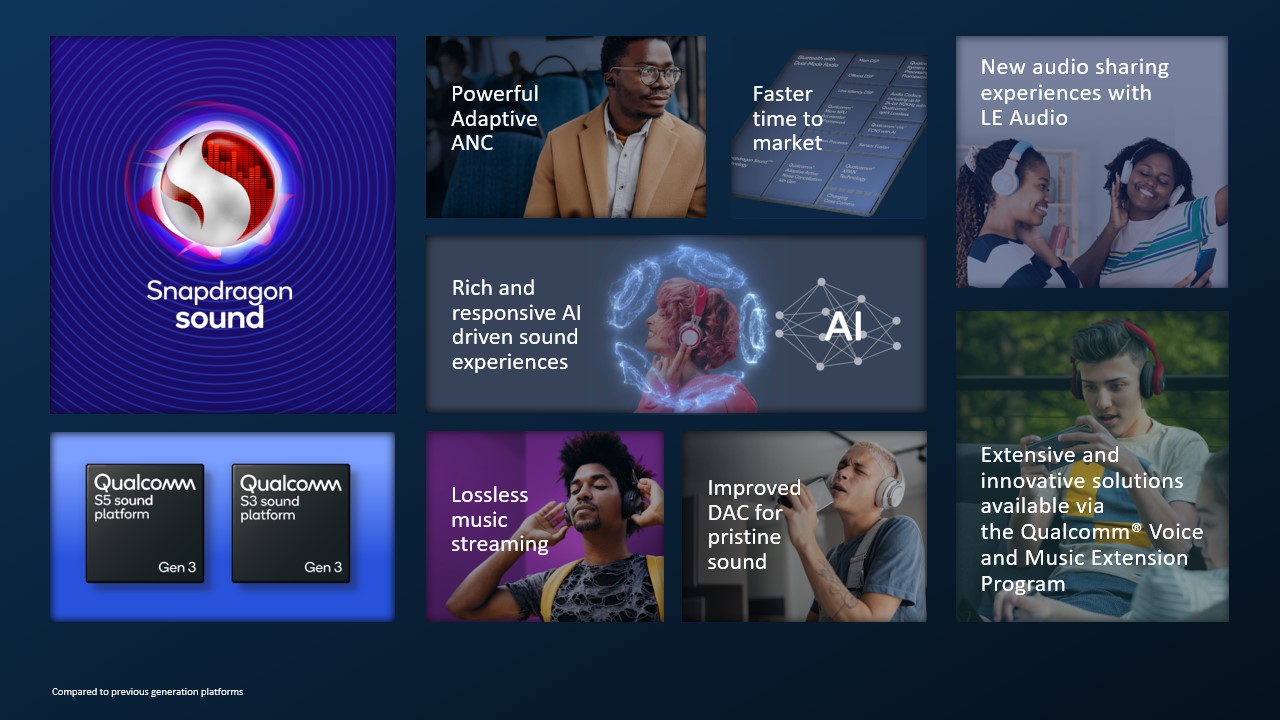
Qualcomm has been busy. But then again, when is it ever idle? On March 25, the company famous for its wireless solutions, software, and semiconductors introduced two next-generation Snapdragon Sound offerings to improve the audio experience not just at the premium end of the market, but also to mid-tier earbuds (and possibly even the best budget wireless earbuds), headphones and speakers – namely, the S5 Gen 3 and S3 Gen 3 Sound platforms.
The big headlines? Let's start with the more premium S5 Gen 3, which promises "almost 50x more AI power" (more on this later), a better digital-to-analog converter with improved signal-to-noise ratio and a 40% lower noise floor (to boast 24-bit/48kHz better-than-CD-quality sound using the more efficient Bluetooth LE Audio), and Qualcomm's 4th-generation adaptive active noise cancellation.
S5 Gen 3 also boasts 50% more memory than the Qualcomm S5 Gen 2 Sound Platform it succeeds and, says Qualcomm, "dedicated cores for audio curation, including hearing loss compensation, ANC, transparency and noise management". Yes, we're looking at a future where your listening gear will not only support Auracast audio sharing (using Bluetooth 5.4), but can then tailor said broadcast to various degrees of hearing loss with ultra-low latency, in real-time.
What of that heavy uptick in AI capabilities? John Turner, Qualcomm's Senior Director of Product Management at Qualcomm Technologies International, told me it's hard to give precise user-case improvements because that'll largely depend on what manufacturers want their products to do (Qualcomm offers solutions, engineers get to work harnessing them), but aside from the plethora of noise cancellation filters it affords, there are two main aims they've spoken of. The first? "A big advancement we've spoken about is getting on-device microphones to intelligently hear your voice in the office, not the voices of those around you". The second is voice control of the actual earbuds or headphones themselves (as opposed to mere access to your chosen voice assistant), where touch capacitive on-ear playback controls are still proving a little unreliable.
These two things are something I'd truly love from my earbuds – and I'm sure I'm not alone.

Entry-level headphones are set to get a lot better too
On to Qualcomm's S3 Gen 3 proposition and here in the mid-tier arena, the firm has added support for its own Qualcomm Voice & Music Extension Program, which has been around for some time within its S5 tier but is now being made available at S3 level – for the first time.
What does this mean for buyers on a budget? Qualcomm tells me developers will be able to add perks such as fit- and hearing tests, spatial audio solutions, heart-rate monitoring, and other health-tracking options within more affordable earbuds and wireless headphones, that's what.
Furthermore, we know that this particular S3 Gen 3 platform will initially be adopted by Vivo with announcements on incoming devices expected in the next couple of weeks. It's a company whose smartphones have received extensive coverage from TechRadar, but its (very affordable) earbuds haven't – yet…
Since launching its premium Snapdragon Sound S7 and S7 Pro Gen 1 platforms last October, Qualcomm tells us its extensive customer research has proven that 69% of buyers are willing to spend more to get better quality audio, 70% actively want lossless audio, 73% of customers make sure they're getting better audio every time they buy, and – perhaps most interestingly – 68% of people want to use the same product for every use case scenario.
Could this be the end to the best running headphones, when the very best wireless earbuds should be good enough for the job thank you very much? Quite possibly – because if even your most affordable earbuds can monitor your health, why would you need another pair?







